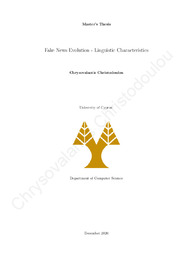Fake News Evolution - Linguistic Characteristics

View/
Date
2020-12-21Author
Christodoulou, Chrysovalantis S.Publisher
Πανεπιστήμιο Κύπρου, Σχολή Θετικών και Εφαρμοσμένων Επιστημών / University of Cyprus, Faculty of Pure and Applied SciencesPlace of publication
CyprusGoogle Scholar check
Keyword(s):
Metadata
Show full item recordAbstract
Recently, the misinformation pandemic, known as \say{infodemic}, has been flooding the internet and social media. The crisis of misinformation is rapidly infecting our daily lives, and its impact on society and democracy worsens. The influence of fake news in events like the COVID-19 pandemic and the 2020 US presidential election indicate the urgent need to reduce the spread and penetration of misinformation and fake news, made from users either knowingly or inadvertently. Many recent approaches seek to mitigate misinformation through automatic identification with artificial intelligence techniques. However, due to the complexity of the problem, most of the algorithms are too specific with no generalized outcomes. In this work, we believe that the only way to stop this \say{infodemic}, is hidden in analyzing and understanding the evolution of it through time. Therefore, we developed a crawler to gather articles from trusted and untrusted sources, covering a period of 10 years. By collecting these articles, we construct a comprehensive dataset containing almost daily basis data with 500K documents. Having the dataset allows extracting a plethora of different linguistic features, for each article, indexing and visualized them to study their evolution. To the best of our knowledge, no previous work proposed any similar contribution.
